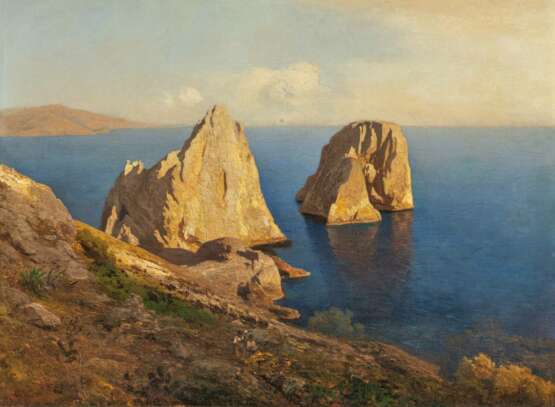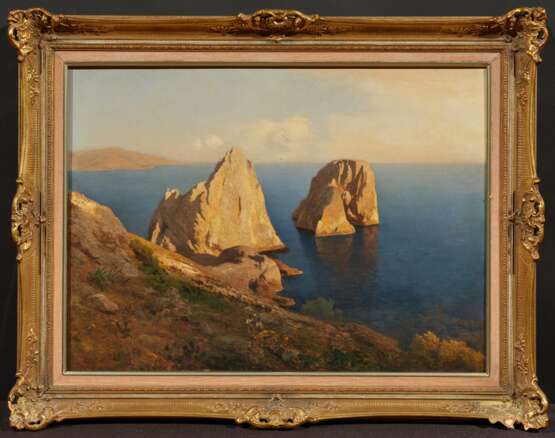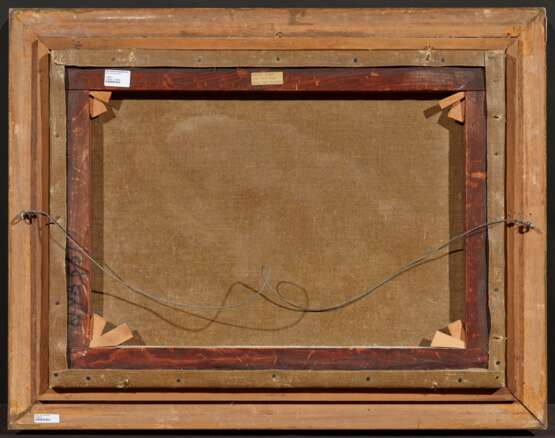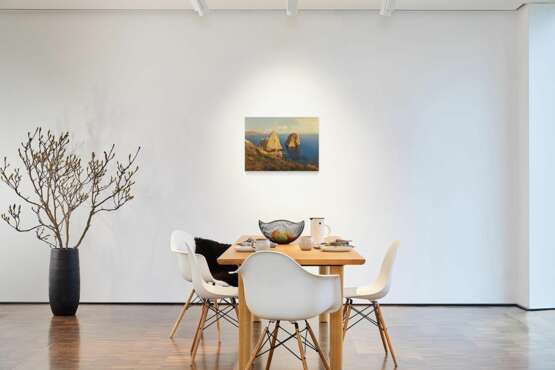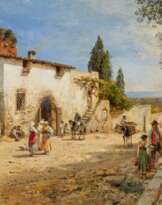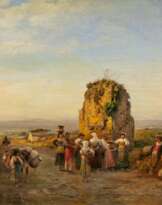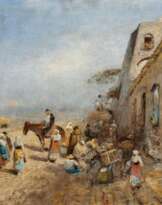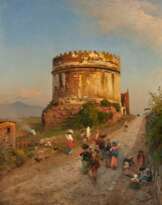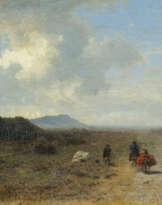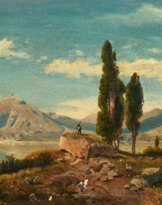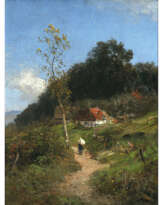ID 1208136
Lot 1150 | Albert Flamm. The Faraglioni Rocks near Naples in the Evening Light
Valeur estimée
€ 3 000 – 5 000
attributed
Title: The Faraglioni Rocks near Naples in the Evening Light.
Technique: Oil on canvas.
Mounting: Relined.
Measurement: 53 x 71,5cm.
Frame: Framed.
Provenance:
Private ownership, Germany.
Like his close friend and brother-in-law Oswald Achenbach, Albert Flamm, one of the leading landscape painters of the later Düsseldorf school of painting, specialised in Italian motifs. His views of Rome, the Campagna, Naples and southern Italy, often enlivened with folkloristic staffage, are still very popular today.
Last year we were able to celebrate the 200th birthday of the Cologne-born artist and so it is a retroactive tribute that this catalogue is enriched by five works by Flamm.
Albert Flamm initially studied architecture at the Düsseldorf Academy of Art, but turned to painting in 1841 and became a pupil of Andreas Achenbach. He quickly became close friends with Achenbach's brother Oswald, who was four years younger than Flamm himself. In 1845, they undertook their first joint study trip to northern Italy. The second trip to Italy, which the friends set off on in 1850, was probably decisive for Flamm. While Oswald Achenbach returned to Düsseldorf after four months, Albert Flamm, who had found his artistic home, stayed in Rome for over three years and also travelled to Naples and Sicily from there. But he, too, eventually returned to Düsseldorf, although he continued to make the gruelling journey south over the following decades. Flamm was deeply rooted in Düsseldorf, he was a founding member of the artists' association "Malkasten" in 1848, he was socially established and married the sister of Oswald Achenbach's wife in 1860. From 1870, Flamm also represented his brother-in-law as a teacher at the academy for a time.
Albert Flamm, like Oswald Achenbach, had captured the spirit of the times with his Italian motifs. In the course of the 19th century, the advancing emancipation and economic and social rise of the bourgeoisie was accompanied by the pursuit of classical education and the desire for (its) representation. Anyone who thought highly of themselves wanted to get to know the country that had been the main destination of the aristocracy's "grand tour" through Europe since the Renaissance. For the majority of citizens, however, Italy as a destination of longing was physically (almost) unreachable. Travelling to the south was long, expensive and certainly uncomfortable.
The travel impressions brought back from Italy by Albert Flamm therefore sold extremely well on the young, newly organised market with an increasingly institutionalised exhibition system in northern Europe, but also in the USA.
The bourgeois salons were given a "window to the south" with views of Rome and its environs, Naples and Venice. The artist's choice of motifs is comparable to today's Instagram selection: Tourist highlights and architectural icons were just as worthy of depiction as picturesque scenes from everyday life.
Flamm's great skill lay in the painterly rendering of the mood of the light and the colouring.
Two of the paintings represented here, the sweeping view of the Campagna di Roma (lot 1147) and the Via Appia with the Torre di Cecilia Metella (lot 1149), show the landscapes so typical of Flamm in the warm light of the setting sun.The streets draw the viewer's gaze into the paintings, in which the women standing at the fountain or the people with folkloristic details, who appear small next to the ancient landmark, liven up the tranquil landscapes.These signed but undated paintings demonstrate Flamm's masterful use of his painterly skills.
Two other of Albert Flamm's paintings presented here depict rural life in front of farmsteads in glistening sunshine. Haze and dust are in the air and turn lot 1148 into a fantastic late Impressionist, hot breath of colour. Despite the fast and confident brushwork, the artist lovingly renders fine details, such as the clergyman looking at the scenery in the open door.
Lot 1146 is comparable to the aforementioned painting in terms of the lighting mood and motif, the unloading of a hay cart. Once again, the composition draws the viewer's gaze into the depths, but the shimmering sea in the background (the Gulf of Naples?) absorbs the dynamic and lends the work a stronger sense of calm. The brightness of the scene can be seen from the pleasant shadows.
The view of the Faraglioni rocks off the coast of Capri (lot 1150), attributed to Albert Flamm, conveys a sublime calm. From an elevated position on the shore, the viewer's gaze falls down onto the rocks, which stand there in majestic grandeur. It is a rarely observed moment of calm; the sea surface is completely still and reflects the cliffs in total clarity. But this vast seascape is also alive with people. Two small female figures can be seen on the coastal slope. They emphasise the size and vastness of what we see. These five paintings by Albert Flamm give a comprehensive impression of the versatility of Italian impressions, which timelessly fulfill the longing for the south.
| Artiste: | Albert Flamm (1823 - 1906) |
|---|---|
| Technique appliquée: | Huile |
| Catégorie maison de vente aux enchères: | Peinture 19ème siècle |
| Artiste: | Albert Flamm (1823 - 1906) |
|---|---|
| Technique appliquée: | Huile |
| Catégorie maison de vente aux enchères: | Peinture 19ème siècle |
| Adresse de l'enchère |
VAN HAM Kunstauktionen GmbH Hitzelerstr. 2 50968 Köln Allemagne | ||||||||||||||
|---|---|---|---|---|---|---|---|---|---|---|---|---|---|---|---|
| Aperçu | |||||||||||||||
| Téléphone | +49 221 92586215 | ||||||||||||||
| Fax | +49 221 92 58 62 4 | ||||||||||||||
| Commission | 32% | ||||||||||||||
| Conditions d'utilisation | Conditions d'utilisation | ||||||||||||||
| Heures d'ouverture | Heures d'ouverture
|
